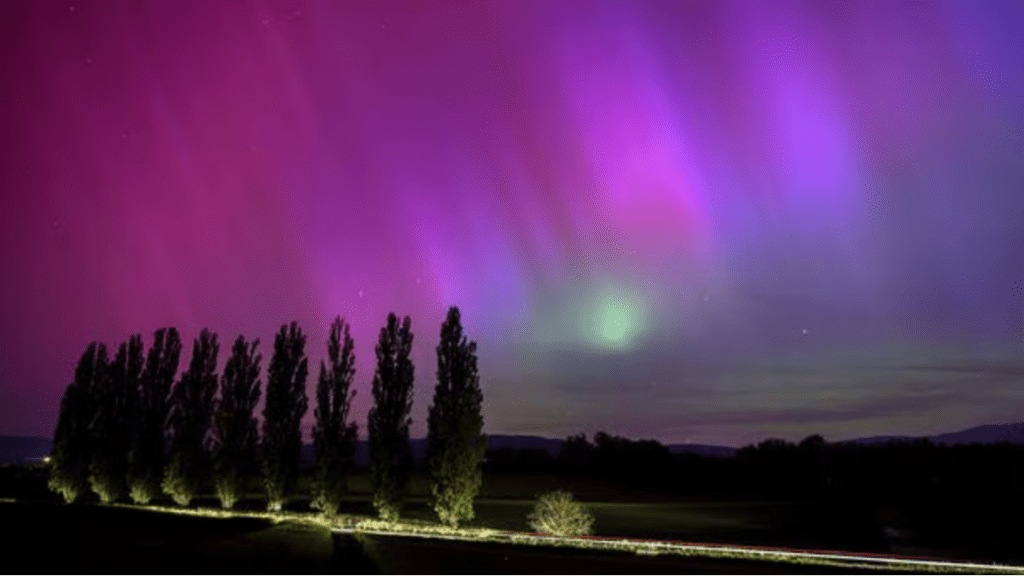A powerful solar storm early Saturday struck Earth causing breathtaking colour displays in the skies throughout the Northern Hemisphere. As of now, there have been no complaints of power outages or communications problems.
The uncommon severe geomagnetic storm warning was issued by the U.S. National Oceanic and Atmospheric Administration (NOAA) on Friday afternoon, when a solar outburst reached Earth several hours earlier than expected. However, it was difficult to forecast and experts emphasised that it would resemble greenish hue splashes rather than the vivid colour curtains typically associated with the northern lights.
The effects of the Northern Lights, which were clearly visible throughout the United Kingdom, were predicted to linger into next week as well as through the weekend.
Vincent Ledvina shared a video through Instagram showing how his curiosity helped him witness the beauty of the aurora in Ladakh’s Hanle. Ledvina wrote on Instagram, “Can’t believe I got this shot all the way from India! This is such a rare occurrence here. I am so stoked! Who saw the aurora last night? We just had the strongest geomagnetic storm in 20 years.” This PhD student and photographer’s video is a compilation of images that depict his experience seeing this amazing natural event.
NOAA’s prediction
The Federal Emergency Management Agency and operators of spacecraft and power stations in orbit were notified by NOAA to take protective measures.
“For most people here on planet Earth, they won’t have to do anything,” said Rob Steenburgh, a scientist with NOAA’s Space Weather Prediction Center. Steenburgh and his colleagues further said that the best aurora views may come from phone cameras. “That’s really the gift from space weather: the aurora,” he added. Mike Bettwy, operations chief for the prediction centre, said, “snap a picture of the sky and there might actually be a nice little treat there for you.”
Additionally, there is a chance that satellites will be impacted, which could interfere with Earthly navigation and communication services. For instance, in 2003, a strong geomagnetic storm destroyed electrical transformers in South Africa and knocked out power in Sweden. According to NOAA, transmissions between GPS satellites and ground receivers may be lost or jumbled even after the storm has passed. However, Steenburgh pointed out that since there are so many navigation satellites, any disruptions ought to be brief. “We are not anticipating that but it could come close. This storm poses a risk for high-voltage transmission lines for power grids, not the electrical lines ordinarily found in people’s homes,” NOAA space weather forecaster Shawn Dahl said.
Since Wednesday, the sun has been generating powerful solar flares that have caused at least seven plasma explosions. The sun’s outer atmosphere, or corona, can release billions of tonnes of plasma and magnetic field with each eruption, which is referred to as a coronal mass ejection. According to NOAA, the flares appear to be connected to a sunspot that is sixteen times the diameter of Earth. All of this is a result of the sun’s activity increasing as it gets closer to the culmination of its 11-year cycle.
NASA says….
NASA said the storm posed no serious threat to the seven astronauts aboard the International Space Station. The biggest concern is the increased radiation levels, and the crew could move to a better shielded part of the station if necessary, according to Steenburgh. Increased radiation also could threaten some of NASA’s science satellites.
“Extremely sensitive instruments will be turned off, if necessary, to avoid damage. Several sun-focused spacecraft are monitoring all the action. This is exactly the kind of thing we want to observe,” Antti Pulkkinen, director of the space agency’s heliophysics science division, said.
(with inputs from AP)

